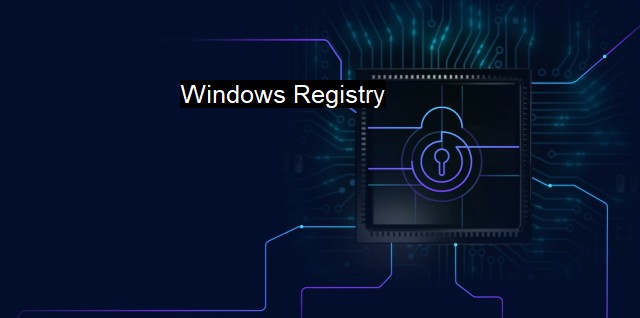What is Windows Registry?
Understanding the Critical Role Windows Registry Plays in Cybersecurity and Antivirus Protection: A Comprehensive Overview and Explanation of the Centralized Database That Stores and Provides Access to Crucial System Configuration Settings.
The Windows Registry, essential to the proper functioning of any Windows operating system, is an extensive database that stores low-level settings and system-wide configurations critical to the operation of the software and hardware components of a computer.Understanding the Windows Registry is vital as it often furnishes a rich source of information for threat detection and problem-solving. It is in the registry that various indications of malware intrusion, such as unfamiliar changes and suspicious entries, may be detected.
Despite the user-friendly interface that Windows offers, at its core, the operations are constantly fed by and feeding into the Windows Registry. Consider entries like an event log in a ship’s navigation system; the entries record important changes to the system like software installations, user preferences, and device connections. The database structure of the registry is built as a hierarchical tree that organizes these entries into five dedicated sections known as hives – keys and values are stored in these hives and further divided into subkeys. Each hardware component, software program, and even the operating system has their configurations rooted in these hives.
On its own, the Windows Registry does not establish a risk from a cybersecurity standpoint. its value becomes apparent in the hands of experienced cybercriminals. Once malware enters the system, it's typically the registry entries that see changes and anomalies. Unauthorized alterations in the registry, ranging from settings adjustments to invalid entries, can change how the computer operates or how the system applications behave.
One of the most common tactics that cybercriminals employ is using registry keys to ensure their malware continues running. Some manage persistence by modifying “run keys” or adding script paths to the registry so the malicious software starts automatically when the system boots. Compromised registry keys might also affect some legitimate processes by hijacking them, such that the process actuates not only legitimate events but also some corresponding malware functionality.
In the face of such threats, knowing how to navigate and analyze the Windows Registry becomes an absolute necessity. Done manually, this is a meticulous and scientific process requiring deep understanding not only of the spectrum of legitimate entries but also those that seem ambiguous or suspicious. due to the volume of data and complexity of information in the registry, manual analyses are often impractical and error-prone.
This is where antivirus solutions step in. Modern antivirus software incorporates the ability to read and track changes in the Windows Registry, providing an important string to its bow. These applications create alerts in case of concurrent modifications or suspicious entries and can often obliterate these issues automatically.
Antivirus solutions are also equipped with advanced registry cleaners that remove unused, irrelevant, redundant, or potentially harmful items, thereby not only optimizing the system’s performance but also stripping cybercriminals of any opportunity to misuse the registry. Some have targeted scanning engines for detecting modifications made by specific threats. During a full-system antivirus scan, one facet checked is the existing registry state, much like checking the pulse for vital signs.
The Windows Registry serves as both the nervous system directing the operation of a Windows machine and as a potent indicator of security compromise or system malfunction. Approaching the information it holds from a cybersecurity perspective amplifies the importance and utility in maintaining and operating safe, secure systems. Investment in solid antivirus protection underscores this approach, offering a robust shield and an effective axe in one – guarding the registry from cyber threats and hacking out the unwelcome intruders.

Windows Registry FAQs
What is the Windows Registry?
The Windows Registry is a database where Windows stores information about the configuration of the operating system, installed software, and user settings. It is a critical component of the Windows operating system.Can modifying the Windows Registry improve my computer's performance?
Yes, modifying the Windows Registry can improve the performance of your computer. However, it is not recommended for inexperienced users to modify the registry as making the wrong changes can lead to system instability or even cause the system to crash.Can malware affect the Windows Registry?
Yes, malware can often modify the Windows Registry to achieve its malicious goals. Malware can add or delete registry keys, modify existing keys or values, or launch malicious code from the registry. It is important to regularly scan your system with antivirus software to detect and remove any malware that may be affecting the registry.How can I fix errors in the Windows Registry?
To fix errors in the Windows Registry, you can use the built-in tool called "Registry Editor" or third-party software designed for this purpose. However, it is important to exercise caution when making changes to the registry and to backup the registry before making any changes. If you are unsure about making changes to the registry, it is recommended to seek the help of a qualified professional.| | A | | | B | | | C | | | D | | | E | | | F | | | G | | | H | | | I | | | J | | | K | | | L | | | M | |
| | N | | | O | | | P | | | Q | | | R | | | S | | | T | | | U | | | V | | | W | | | X | | | Y | | | Z | |
| | 1 | | | 2 | | | 3 | | | 4 | | | 7 | | | 8 | | |||||||